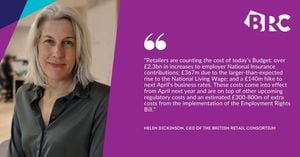Delhi is enduring one of its worst pollution crises yet, with air quality levels skyrocketing and cloaking the Indian capital in thick, suffocative smog. On Tuesday, pollution levels hit alarming figures, with the Air Quality Index (AQI) reaching 488, placing it squarely in the 'severe plus' category. Stagnant weather combined with increasing smoke from agricultural burning has created conditions where pollution doesn’t disperse, leaving residents to contend with hazardous air.
This year’s pollution crisis has pushed the city’s air quality to levels deemed dangerously unhealthy. According to reports, some areas exhibited levels of pollution over thirty times the maximum healthy threshold. The effect of these conditions is far-reaching, with officials noting the detrimental impacts on public health, leading to emergency measures throughout the region.
To combat this environmental emergency, authorities implemented stringent measures as part of Stage IV of the Graded Response Action Plan. This includes banning the entry of non-essential trucks, shutting down construction sites, and moving schools to online classes, hoping to shield children and citizens from the toxic air.
The underlying factors contributing to this catastrophic air quality are numerous and complex. Stagnant winds associated with plummeting temperatures play a significant role by trapping pollutants close to ground level. During the transition to winter, the smog creeps in, exacerbated by emissions from millions of vehicles and industrial activities, as well as smoke from burning garbage and toxic stubble from fields. Reports indicate field burning contributes as much as 40% to Delhi's air pollution. Despite the illegality of this practice, it has become common as farmers clear their fields after the rice harvest, which is now caught under scrutiny from environmental advocates.
On top of pollution caused by local activities, the region is also battling legal and governmental hurdles. Just last month, India's Supreme Court emphasized clean air as a fundamental human right, compelling both central and state governments to take corrective actions. Yet, measures taken so far have appeared largely ineffective. Complicities between various administrative regions have led to conflicting blame—where the Delhi government accuses surrounding states of contributing to the pollution disaster, and those states push back, trading barbs with Delhi's leadership.
Individuals across the socio-economic spectrum are feeling the brunt of this yearly environmental calamity. Shagun Devi, 34, lives with her family in Okhla, one of Delhi’s dense neighborhoods. Struggling to make ends meet as a domestic worker, she reports everyone in her household has been sick for weeks due to the pollution peaks. “The air inside our home feels just as toxic as outside,” she lamented. Saving enough for even basic air quality devices is beyond her reach.
Stories like Devi’s represent the harsh reality faced by many of Delhi's nearly 30 million residents. Sheikh Imamuddin, 70, voices desperation from the vantage point of his roadside book stall. Suffering from chronic asthma exacerbated by the pollution, he's haunted by the effects of the toxic atmosphere on his health. “I know this air is killing me slowly, but I can't afford to stay indoors. Every penny counts, and my job doesn't allow for me to take breaks,” he explained, reflecting on the grim choices many faced.
On another front, workers reliant on outdoor jobs feel neglected, as air pollution has turned hazardous not just to health but to livelihoods. The rich-poor divide is stark and troubling; those with financial means can escape to cleaner locales, such as Aarti Sharma, who fled to Kerala to avoid the pollution's assault. “Living here is unbearable. I can’t comprehend how those worse off than me cope,” she described her experience.
The issue of pollution isn’t just personal; it has political ramifications. Recent discussions at COP29 have elevated the urgency for action. Experts at the conference underscored the need for nations embroiled with air quality crises to tackle these conditions decisively. Aarti Khosla, director of Climate Trends, voiced the urgency of addressing health risk challenges: “When will we prioritize lives over other pressing issues? The time for tangible solutions is now!”
While rain is anticipated to sweep through the capital soon, providing potential relief, many locals remain skeptical. History tells them this might be just enough to wash away some pollutants temporarily, but soon, they could return to the same deadly smog.
This year’s pollution disaster is but another chapter of Delhi's annual struggle with toxic air, and the stakes have never been higher. Rising visibility problems and respiratory ailments are on the rise, but the residents must endure, count the days until the city’s atmospheric conditions improve, and hold out hope for actionable changes from those they have entrusted with power.
Delhi's air pollution crisis serves as a reminder of the urgent need for policy changes, stricter regulations, and public awareness to stave off this recurrent environmental threat. Without strong, collaborative efforts from all levels of government and community advocacy, the plight of those like Shagun and Sheikh will only deepen as smog settles once again over the capital.



